Gardens are extensions of their caretakers’ personalities and interests, but often they are mostly hidden from view. Last week, I had the good fortune to attend the Eastham Garden Tour. It is a special thing to be allowed to walk the back yards and gardens of people you don’t know, their lovingly tended efforts there for all to see. Five gardens were featured, nestled on back roads that wind through the vast salt marshes and tidal creeks of town.
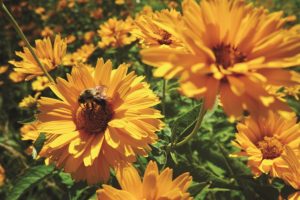
The tour is part of the broader Cape Cod Hydrangea Festival. So, the focus was, of course, hydrangeas. They are in full bloom now and were on display in all their luscious, round, puffy glory, fat and ripe like clusters of grapes on bent stems. I love hydrangeas as much as the next person, but I went with an eye to discovering what else is blossoming in Eastham’s secret gardens.
Among these gardens, whether designed especially for bees and butterflies or for body and soul, for marsh views, or to evoke the sea, were plants for pollinators. Lots of them. I was delighted to see so many native and naturalized species humming and vibrating with bees and butterflies. There were entire swaths of these plants in full, explosive display, waving their colorful, vibrant petals to the sky, dancing in the wind, irresistible to the bees and to the visitors who walked, slow and thoughtful, through the garden paths.
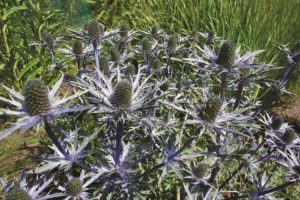
Pollinator garden plants provide the nectar and pollen the native insect and animal populations depend on as a food source. They are key elements of support in a thriving ecosystem.
The nectar and pollen these plants produce is the offering that bridges the gap between the kingdoms of Plantae and Animalia. The taking of nectar is a symbiotic exchange between the highly mobile, complex animal and the rooted, sugar-and-pollen-producing plant. It is a genesis moment, a delicate dance of creation, in which two work together to create something more than either might achieve alone.
I believe nature has a cosmic sense of humor, and when you watch all this you can see pollination is one of her smile-inducing processes.
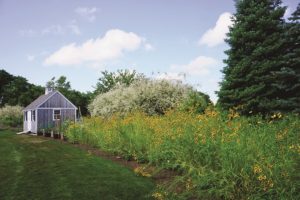
The plant “wants” its pollen to spread so that more fruit will be produced, so its genetics will continue to spread. Wind will do. But why not offer a sugary treat to those who fly? When the bee, the butterfly, the bird, or the wasp is drawn in by a plant’s divine ambrosia, its body is covered in pollen. As it flies from flower to flower in its love-drunk nectar frenzy, it delivers the pollen to as many other flowers as it can. It’s no accident that the part of the flower containing all the pollen, the anther, must be brushed past to reach the flower’s nectar, hidden deeper within.
This process ensures the survival and spread of the plant. And also, therefore, of the bees. And, so, the birds. Because all things are connected, the food we eat begins one way or another in the plant system. Pollen is important to our very existence.
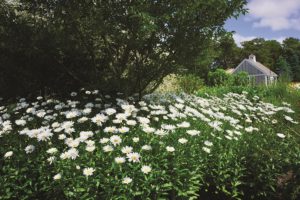
Pollinator gardens are attractive to humans, too. The plants I saw in Eastham’s gardens were sun-loving, bright summer bloomers. There were masses of golden-orange butterfly weed, butterfly bushes with tight cone clusters in pink and purple, a rainbow’s array of echinacea, buttery coreopsis, vibrant phlox, juicy, purple clusters of joe-pye weed blossoms, held high on lance-shaped leaves, masses of white Shasta daisies swaying with the breeze, baptisia, yarrow, licorice-scented Agastache, and the delicate purple masses of nepeta that are more bumblebee than plant this time of year. I even saw sea holly, a plant that looks like a sculpture cast in copper and left to patina to a powdery blue.
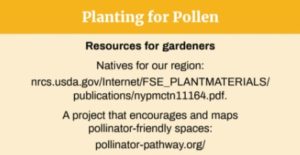 Incorporating these pollinator-nurturing plants into your garden is simple. Being mostly native, they are the plants that do well in our existing conditions without too much input from the gardener. If you have a sunny area in your yard or garden, plant them in masses for both visual and environmental impact. There are mixes of native wildflowers available that can be spread like lawn seed in spring or late fall in that forgotten back patch of your yard. Alternative lawn mixes are another option for making your yard and garden a bigger part of this miraculous plant-animal symbiosis, but simply welcoming the clover and dandelions that want to grow instead of grass is a vote for this system.
Incorporating these pollinator-nurturing plants into your garden is simple. Being mostly native, they are the plants that do well in our existing conditions without too much input from the gardener. If you have a sunny area in your yard or garden, plant them in masses for both visual and environmental impact. There are mixes of native wildflowers available that can be spread like lawn seed in spring or late fall in that forgotten back patch of your yard. Alternative lawn mixes are another option for making your yard and garden a bigger part of this miraculous plant-animal symbiosis, but simply welcoming the clover and dandelions that want to grow instead of grass is a vote for this system.
We garden, in part, to participate in nature, in a thing so much greater than ourselves. Growing plants that feed this system is one way to do that with results that are surprisingly profound to witness.



